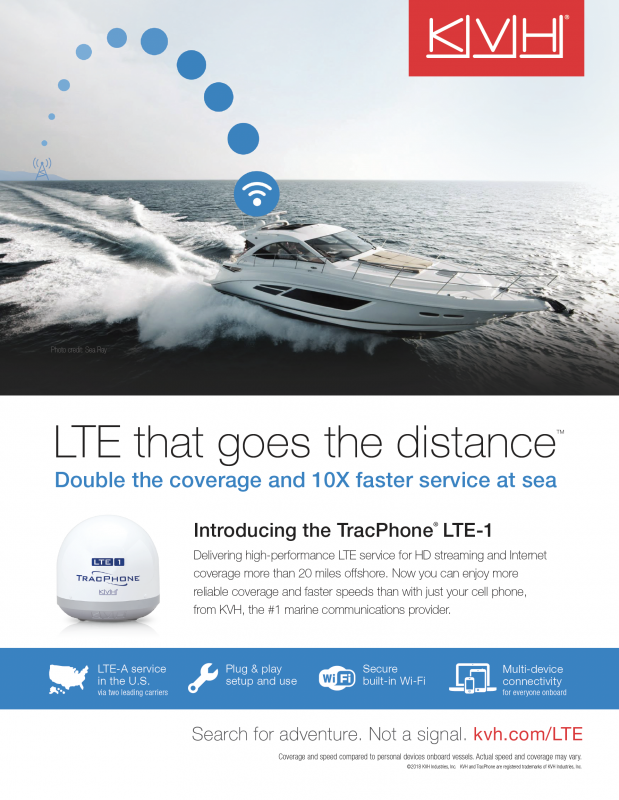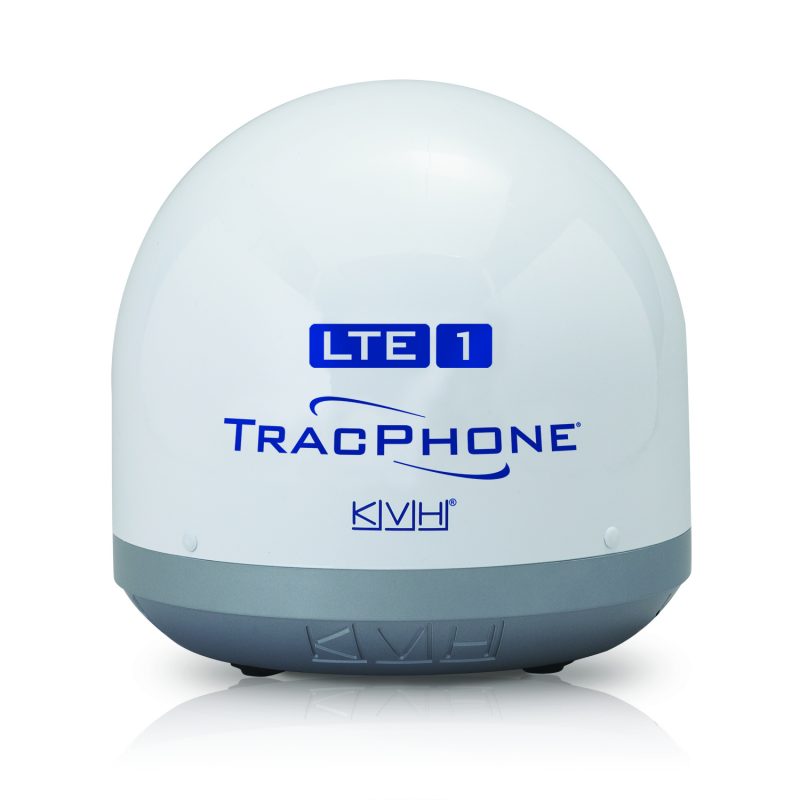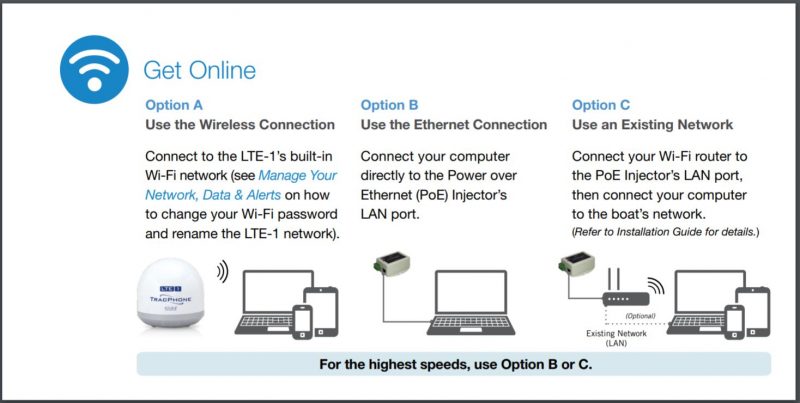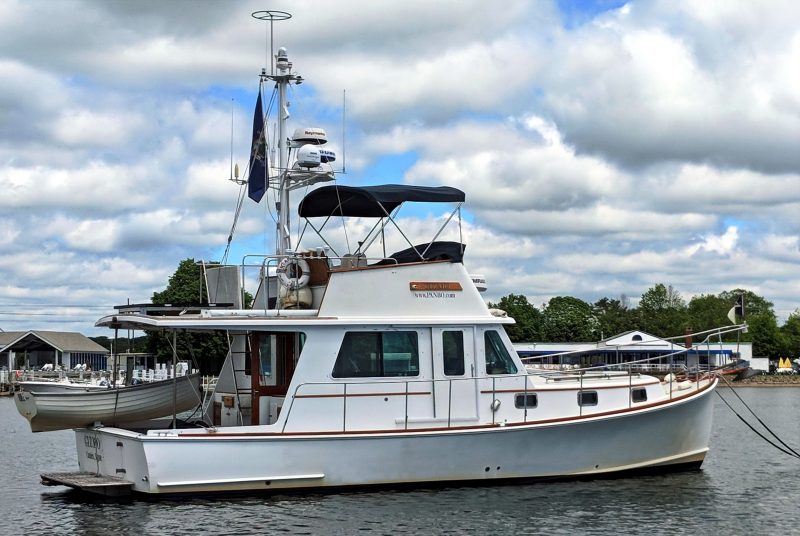KVH enters the cellular Internet market
 KVH announced they’ve entered the cellular internet market with the TracPhone LTE-1. Their marketing materials say it can deliver “Double the coverage and 10x faster speed at sea.” KVH is providing the hardware and the cellular service and promises to deliver an all-in-one, end-to-end, no hassle, simple service. If this announcement weren’t from KVH and it didn’t have some of the pretty bold claims KVH makes it might look like just a ho-hum, me too announcement. But, KVH says they can do more faster and easier than the existing products so, I for one, am looking forward to seeing if this, generally pretty conservative, engineer driven company, can back them up.
KVH announced they’ve entered the cellular internet market with the TracPhone LTE-1. Their marketing materials say it can deliver “Double the coverage and 10x faster speed at sea.” KVH is providing the hardware and the cellular service and promises to deliver an all-in-one, end-to-end, no hassle, simple service. If this announcement weren’t from KVH and it didn’t have some of the pretty bold claims KVH makes it might look like just a ho-hum, me too announcement. But, KVH says they can do more faster and easier than the existing products so, I for one, am looking forward to seeing if this, generally pretty conservative, engineer driven company, can back them up.
The system
The KVH TracPhone LTE-1 is an all-in-one unit providing LTE (AKA Cellular or 4g) connectivity to your boat. The dome –which is the same one used for KVH’s TV-1– is designed to sit on a hardtop, radar arch, or mast and connect to the devices in the boat via a wired Ethernet cable or WiFi. The system contains two LTE antennas in a 2×2 MIMO array, an LTE-A radio, wireless router and GPS receiver. It can be mounted to a flat surface with four vibration isolated mounts or using a 1″ 14 VHF antenna style mount. Power is delivered to the LTE-1 via POE and input power can range from 9-36 VDC. The POE module also has a wired Ethernet connection for connecting the LTE-1 to your existing boat network.
KVH delivers on their promises in part by leveraging an LTE-Advanced (LTE-A) feature called carrier aggregation which allows the LTE radio to connect to multiple LTE bands (bands are portions of radio frequency spectrum) and aggregate the bandwidth from those bands to deliver greater throughput. The LTE-1 is configured with two carriers with one designated as the primary. If the primary carrier becomes unavailable the secondary carrier takes over. 6/25/18 – A note of clarification: Though the name can be confusing carrier aggregation occurs across multiple frequencies of a single cellular network. So, although the LTE-1 works with two carriers it can only use one at a time.
The WiFi radio in the system is a 2.4ghz 802.11n/g radio which maxes out at 72 Mbps. Because the LTE-1’s LTE-A radio is capable of higher speeds than the WiFi radio KVH recommends using a wired connection to an existing boat network or access point.
LTE-1s are managed via an Android and iOS app or via a web interface. The systems have an MSRP of $1,699. KVH calls this an end-to-end offering because they supply the hardware and the cellular service. They’re currently offering one rate plan with 20gb of bandwidth for $200 per month. Additional data is available for $9.99 per GB and if you’d like to suspend service you can do that for $9.99 per month. KVH is very clear there’s no throttling of the bandwidth. You’re not able to use your own SIM card or existing cellular plan. KVH is taking pre-orders now but hasn’t said when devices will start shipping.
The promise
Although this is their first cellular product, KVH brings many years of experience deploying complex systems to deliver high reliability connectivity to boats all over the globe. KVH has a very strong dealer / installer network, deep experience negotiating complex services with bandwidth providers and very highly rated customer service. Now, they’re bringing that experience to the cellular internet space.
KVH says they can deliver up to 100 Mbps download and 50 Mbps upload speed up to 20 miles offshore. It looks like the foundation for these claims is latest generation technology, carefully engineered RF systems and unthrottled bandwidth provided by multiple carriers. Incidentally, thus far KVH has declined to identify those carriers.
Customers with mini-VSAT systems can also use the LTE-1 to provide much less expensive connectivity when the boat is within range of cellular networks. KVH says that a KVH CommBox software bundle and setup by KVH Application Engineering is required.
How’s it compare?
Panbo has previously looked at all-in-one systems from Glomex, Shakespeare, and Winegard. Each of these systems has a little bit different spin on the basic concept. Let’s get one thing out of the way first, the LTE-1 doesn’t currently have the ability to act as a WiFi bridge. Each of the other three systems also contain WiFi radios designed to allow connecting to shore based WiFi and share the connection within the boat.
Glomex and Shakespeare ship without a SIM card and expect you will get your own service plan. Winegard follows a similar model to KVH but only supports one carrier so they don’t have any of the carrier aggregation magic. But, with a $479.00 MSRP and service options ranging from from $20.00 (1 GB) to $150 (20 GB), Winegard does come in at a lower price point. Shakespeare with a $899 MSRP and Glomex with a $995 MSRP are also less expensive, though you’ll need to procure your own cellular service.
In the LTE-1 FAQ KVH says they’re hoping to add Caribbean access to their service offerings. I believe the radio in the LTE-1 is also capable of service in many other markets so we’ll have to watch and see if the coverage footprint expands further.
Ben Ellison has a prototype unit installed on Gizmo, so, we will hear from him about KVH’s ability to back up their talk once he’s had a chance to adequately test the system. I have a Winegard Connect and Shakespeare WebWatch on Have Another Day so we can compare notes.
















$2k for a cellular router and $200 per month for 20GB data seems a bit excessive even for single vendor solution.
From a technical point of view, this product (or, I should say, “these products” – their competitors included) is bulls–t. Well, unless you enjoy paying $1700 for a $300 router inside an upturned salad bowl.
The real point of this rant will come further down – skip directly to that, if you so wish.
According to FCC filings, this is nothing but an off-the-shelf ($300) Peplink Max BR1 Mini with a Sierra 7455 LTE modem, inside a very oversized plastic dome: http://www.industrialnetworking.com/Category/Cellular-Gatways-Routers-Modems-Mobility-Applications/Peplink-Industrial-Cellular-Router-MAX-BR1-MINI-LTE-US-T
Glomex uses the same concept with their weBBoat deal, only substituting a Teltonika RUT950 off-the-shelf router with a Huawei modem for the Peplink.
Quoting from the article: “It looks like the foundation for these claims is latest generation technology, carefully engineered RF systems and unthrottled bandwidth provided by multiple carriers.”
– Unfortunately: no, no and… no. To offer an 802.11n access point as “latest generation” is not only ridiculous, it is an outright lie – 802.11ac is a mature standard by now (around 10x the Wi-Fi (not cellular) speed of KVH:s product in real-life usage), and 802.11ax devices are becoming available with even higher performance.
Calling this a “carefully engineered RF system” is an insult to RF engineers – the publicly available information regarding this product makes it seem that no RF engineering whatsoever has gone into it – it’s a plain old cellular router with two plain old omnidirectional antennas (possibly non-lousy or even custom ones, for what that’s worth) inside a weather housing.
“Unthrottled bandwidth provided by multiple carriers” – well, not the way you might think – and not the way Ben explains it in this article. No blame on Ben, though: terminology gets more than a bit confusing in these neighbourhoods of techtown. Carrier Aggregation (as supported by the Sierra modem in KVH:s dome – or rather, in the Peplink router that’s inside) is not the aggregation of, say, Verizon and Sprint. It’s the aggregation of “channel A and channel B”. Both of the channels subject to aggregation normally has to be run by the same “carrier” (i.e. company). The word “carrier” has two meanings; among regular folks, it means “cellular provider; company”, but among RF folks it means “channel frequency”.
The combination of two *MNOs* (Mobile Network Operators – like Verizon; the less ambiguous terminology) is a simple “one or the other” deal with more or less (usually “less”) intelligent switching between the two.
———- The takeaway ——————————-
What do you get for the extra $1400, that KVH adds on top of the price of the Peplink router that’s inside?
1) A weather-protective housing that’s probably reasonably easy to install onboard.
2) Perhaps the more important factor, that might make or break this deal for most customers: a single, packaged-deal solution provider. KVH takes care of everything, including the data plan. No effort needed from you. They’ll even install the thing on your boat and hook it up if you pay them to do it.
And what about the $200/month plan fee? According to my very brief market research, it seems like you’re just paying for the over-the-counter cost of the *two* data plans that are baked into it, with an extra ~50% added on top for KVH.
KVH may be an “engineer-driven company” – as the article says – at other times, but not this time. This product is not an engineer’s making, it’s a marketing person’s. An enterprising marketing guy or gal must have eyed all the really cheap plastic TV-1 domes coming from the injection molder, and thought “hmm, perhaps these guys at Glomex are on to something”.
The marketing mumbo-jumbo about the technical superiority of this product have no substance to them whatsoever. It’s a cheap, previous-generation cellular router in a bowl, and that’s all there’s to it.
However, do not let that diminish the real point of a product like this: convenience. This is a convenience product. If all you want is plug-and-play onboard Wi-Fi that’s at least cheaper and faster than VSAT when you’re close to shore, then this might be a deal for you.
For the DIY:ers looking to save $1300, Target has a nice housing that can probably be made reasonably waterproof with some caulking: https://www.target.com/p/plastic-serving-bowl-with-lid-185oz-white/-/A-53097203
Just add your favourite $300 cellular router.
Dale,
I’d already attempted to clarify the use of Carrier Aggregation once but see I didn’t do a good enough job. I’ve added another note to try and tell that story accurately.
Although you may not value it the same as others (and I might be inclined to place similar value to you) the all in one service and support model is very important to many potential users of a product like this. KVH isn’t going for the lowest price point, just like several other marine internet products. I have no doubt you will always be able to roll your own solution for less. But, for many people, that’s not a viable option.
I think KVH has a pretty defensible position on the cost of bandwidth. They’re inline with what Google charges for data with Project Fi at $10/gb. There certainly are cheaper ways to purchase bandwidth but again target audience is a major factor here.
Hi Dale, I’m under a non-disclosure agreement with KVH until the LTE-1 system is finalized, but I can tell you that as much as you know about wireless communications, you do not know everything about the LTE-1. For instance, while there is a Peplink Max BR1 Mini inside, you can not buy this particular model anywhere. In fact, one of the engineers who worked with Peplink on it told me that the serial numbers read “KVH-xxxxxxxxxxxx”.
Also the engineering that KVH did put into the LTE-1 was not about its WiFi connection, which is mainly for device management. As Ben S illustrated above, KVH recommends using the LTE-1’s Ethernet connection with a belowdecks router for best data performance.
KVH just changed the minimum rate for LTE-1 service from $200/month for 20GG to $100/mo for 10GB with the same overage charge of $10/GB (and service suspension fee of $10/mo). So overall it’s a more flexible deal.
But I’ve seen very mixed performance in midcoast’s Maine’s unusual cellular environment. I’ve heard that service is good in other areas but KVH is still at work on fixing the provider issues I’ve experienced.